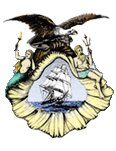
The Navy Department Library
- U-2s, UFOs, and Operation Blue Book
- U-94 Sunk By USN PBY Plane and HMCS Oakville 8-27-42
- U-162 Sunk By HM Ships Pathfinder, Vimy, and Quentin 9-3-42
- U-210 Sunk By HMCS Assiniboine 7-6-42
- U-352 Sunk By U.S.C.G. Icarus 5-9-42
- U-505 Sinking
- U-571, World War II German Submarine
- U-595 Scuttled and Sunk Off Cape Khamis, Algeria 11-14-42
- U-701 Sunk By US Army Attack Bomber No. 9-29-322, Unit 296 B.S. 7-7-42
- U-Boat War in the Caribbean: Opportunities Lost
- Ultra and the Campaign Against U-boats in World War II
- Underwater earthquake disasters and the U.S. Navy
- Uniform Regulations, 1797
- Uniform Regulations, 1802
- Uniform Regulations, 1814
- Uniform Regulations, 1833
- Uniform Regulations, 1841
- Uniform Regulations, 1852
- Expand navigation for Uniform Regulations, 1864 Uniform Regulations, 1864
- General Regulations: Full Dress, Undress, Service Dress
- Coats, Overcoats, Jackets
- Cuff and Sleeve Ornaments
- Pantaloons, Vests
- Part 1: Rear Admiral to Ensign
- Part 2: Engineer Corps
- Part 3: Professors, Secretaries
- Part 4: Medical Corps
- Part 5: Chaplains, Paymasters
- Part 6: Naval Constructors
- Part 7: Regulations for Wearing Shoulder Straps
- Cap and Cap Ornaments
- Straw Hats, Sword and Scabbard, Sword-Belt, Sword-Knot, Buttons, Cravat
- Dress for Petty Officers and Crew
- Uniform Regulations, 1866
- Uniform Regulations, 1869
- Uniform Regulations, Women's Reserve, USNR, 1943
- Expand navigation for Uniforms of the US Navy Uniforms of the US Navy
- Aiguillettes
- Uniform-Buttons
- Chief Petty Officers' Uniforms U.S. Navy
- Cold-Weather/Foul-Weather Wear
- Gas Masks and Breathing Apparatus U.S. Navy Uniform
- Hats/Caps
- Uniform and Dress of the Navy of the Confederate States
- Insignias U.S. Navy Uniform
- Maintenance/Care of Uniforms
- Men's Uniforms
- Pants/Bell-Bottoms
- Personal Appearance
- Seabags
- Navy Seabags
- Shirts/Jumpers
- Shoes
- Swords
- Naval Uniforms, misc.
- Women's Uniforms
- Petty Officer Rating Badge Locations and Eagle Designs
- Uniform Changes
- Historical Surveys of the Evolution of US Navy Uniforms
- Uniform Regulations
- History of US Navy Uniforms, 1776-1981
- Identification Tags ("Dog Tags")
- United States Atlantic Fleet Organization 1942
- United States Pacific Fleet Organization, 1 May 1945
- United States Naval Hospital Ships
- United States Naval Railway Batteries in France
- United States Navy and the Persian Gulf
- United States Navy and World War I: 1914–1922
- United States Navy's World of Work
- Expand navigation for United States Submarine Losses World War II United States Submarine Losses World War II
- Notes to US Submarine Losses in World War II
- Introduction
- Albacore (SS 218)
- Amberjack (SS 219)
- Argonaut (SS 166)
- Barbel (SS 316)
- Bonefish (SS 223)
- Bullhead (SS 332)
- Capelin (SS 289)
- Cisco (SS 290)
- Corvina (SS 226)
- Darter (SS 227)
- Dorado (SS 248)
- Escolar (SS 294)
- Flier (SS 250)
- Golet (SS 361)
- Grampus (SS 207)
- Grayback (SS 208)
- Grayling (SS 209)
- Grenadier (SS 210)
- Growler (SS 215)
- Grunion (SS 216)
- Gudgeon (SS 211)
- Harder (SS 257)
- Herring (SS 233)
- Kete (SS 369)
- Expand navigation for Lagarto (SS 371) Lagarto (SS 371)
- Perch (SS 176)
- Pickerel (SS 177)
- Pompano (SS 181)
- R-12 (SS 89)
- Robalo (SS 273)
- Runner (SS 275)
- S-26 (SS 131)
- S-27 (SS 132)
- S-28 (SS 133)
- S-36 (SS 141)
- S-39 (SS 144)
- S-44 (SS 155)
- Scamp (SS 277)
- Scorpion (SS 278)
- Sculpin (SS 191)
- Sealion (SS 195)
- Seawolf (SS 197)
- Shark I* (SS 174)
- Shark 2* (SS 314)
- Snook (SS 279)
- Swordfish (SS 193)
- Tang (SS 306)
- Trigger (SS 237)
- Triton (SS 201)
- Trout (SS 202)
- Tullibee (SS 284)
- Wahoo (SS 238)
- German U-Boat Casualties in World War Two
- Italian Submarine Casualties in World War Two
- Japanese Submarine Casualties in World War Two (I and RO Boats)
- Unmanned Vehicles for U.S. Naval Forces: Background and Issues for Congress
- US Democracy Promotion Policy in the Middle East
- US-Greek Naval Relations Begin
- US Marines at Pearl Harbor
- US Mining and Mine Clearance in North Vietnam
- US Naval Detachment in Turkish Waters, 1919-1924
- US Naval Forces in Northern Russia 1918-1919
- US Naval Plans for War with the United Kingdom in the 1890s
- US Naval Port Officers in the Bordeaux Region, 1917-1919
- Expand navigation for US Navy Abbreviations of World War II US Navy Abbreviations of World War II
- Expand navigation for US Navy and Hawaii-A Historical Summary US Navy and Hawaii-A Historical Summary
- US Navy at War Second Official Report
- US Navy at War Final Official Report
- US Navy Capstone Strategies and Concepts (1970-1980)
- US Navy Capstone Strategies and Concepts (1974-2005)
- US Navy Capstone Strategies and Concepts (1981-1990)
- US Navy Capstone Strategies and Concepts (1991-2000)
- US Navy Capstone Strategies and Concepts (2001-2010)
- US Navy Capstone Strategy, Policy, Vision and Concept Documents
- US Navy Code Words of World War II
- US Navy Congo River Expedition of 1885
- US Navy Forward Deployment 1801-2001
- Expand navigation for US Navy in Desert Shield/Desert Storm US Navy in Desert Shield/Desert Storm
- Executive Summary
- Overview: Desert Storm - The Role of the Navy
- The Gathering Storm
- A Common Goal - Joint Ops
- Bullets, Bandages and Beans - Logistic Ops
- Thunder and Lightning - The war with Iraq
- Epilogue
- Lessons Learned
- Appendix B: Participating Naval Units
- Appendix A: Chronology - August 1990
- Appendix A: Chronology - September 1990
- Appendix A: Chronology - October 1990
- Appendix A: Chronology - November 1990
- Appendix A: Chronology - December 1990
- Appendix A: Chronology - January 1991
- Appendix A: Chronology - January 1991 cont.
- Appendix A: Chronology - February 1991
- Appendix A: Chronology - March 1991
- Appendix A: Chronology - April 1991
- Appendix C: Allied Participation and Contributions
- Appendix D: Aircraft Sortie Count
- Appendix E: Aircraft Readiness Rates
- Appendix F: Aircraft and Personnel Losses
- Appendix G: Naval Gunfire Support
- Appendix H: Surface Warfare
- Appendix I: Unmanned Aerial Vehicles
- Appendix K: Sealift
- Appendix L: Airlift
- US Navy in the World (2001-2010)
- Expand navigation for US Navy instruction for the destruction of signal books, 1863 US Navy instruction for the destruction of signal books, 1863
- US Navy Interviewer's Classification Guide
- US Navy Libraries
- US Navy Libraries: Historic Documents
- US Navy Motor Torpedo Boat Operational Losses
- US Navy Nurse Corps General Uniform Instructions, 1917
- US Navy in Operation Enduring Freedom, 2001-2002
- US Navy Personnel in World War II: Service and Casualty Statistics
- US Navy Personnel Strength, 1775 to Present
- US Navy Sailors Operating Ashore as Artillerymen Roth
- US Navy Ships Lost in Selected Storm/Weather Related Incidents
- US Navy Special Operations in the Korean War
- US Navy Submarines Losses, Selected Accidents, and Selected Incidents of Damage Resulting from Enemy Action, Chronological
- US Occupation Assistance: Iraq, Germany and Japan Compared
- US Occupation of Haiti, 1915-1934
- US Prisoners of War and Civilian American Citizens Captured
- US Radar: Operational Characteristics of Radar Classified by Tactical Application
- Use of Naval Forces in the Post-War Era
- U.S.S. Colorado BB-45 Diary
- U.S.S. Searaven S.S. 196 4 July 1945
- Expand navigation for USS Constitution's Battle Record USS Constitution's Battle Record
- USS John S. McCain (DDG 56) Memorial Ceremony
- USS Kearsarge Rescues Soviet Soldiers, 1960
- USS Monitor Versus CSS Virginia and the Battle for Hampton Roads
- USS Pirate; Selected documents on the Salvage of USS Pirate and USS Pledge
- USS Vega, Report of Pearl Harbor Attack
- USS West Virgina, Report of Salvage, Pearl Harbor
- The U.S. Navy Enlistment, Instruction, Pay and Advancement
Seabags
Modern Seabag
Seabags, as traditionally Navy as bosn's pipes, are due to have their faces lifted.
Design of a new bag is the problem facing a committee composed of representatives of BuPers, BuShips, BuDocks, BuSandA and CNO.
Four designs have been selected by the committee as those most likely to meet the requirements. Trial bags of these designs are now under actual travel and laboratory tests. They are:
· A collapsible, accordion-type box with plastic reinforced ends, one side of which acts as a lid and is closed by a zipper
· A fabric suitcase which can be laid open or hung up open, having a zipper down both ends and around the bottom.
· Two duffle-type bags, one resembling the present Marine Corps' clothes carrier, and the other similar in general but with a carrying strap, golf bag style, in addition to the handles. Both have zipper closures and side pockets for personal traveling effects.
Enlisted men traveling on orders keep the test bags in a shuttle service, and comment at their journey's end on the advantages and disadvantages of the bag type used.
Source: "Modern Seabag." All Hands. 369 (November 1947): 7.
[END]
Footnotes

- Accessibility/Section 508 |
- Employee Login |
- FOIA |
- NHHC IG |
- Privacy |
- Webmaster |
- Navy.mil |
- Navy Recruiting |
- Careers |
- USA.gov |
- USA Jobs
- No Fear Act |
- Site Map |
- This is an official U.S. Navy web site


